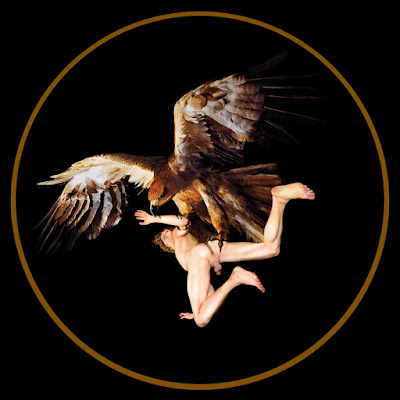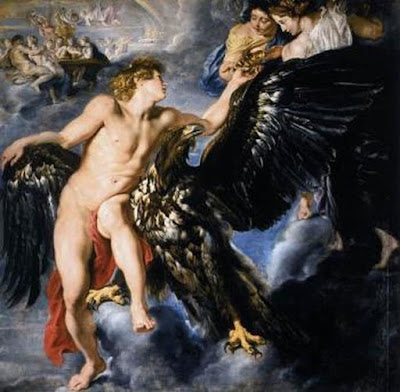GANYMEDES, the son of King Tros who gave his name to Troy, was the most beautiful youth alive and therefore chosen by the gods to be Zeus’s cup-bearer. It is said that Zeus, desiring Ganymedes also as his bedfellow, disguised himself in eagle’s feathers and abducted him from the Trojan plain.
5. The constellation Aquarius, identified with Ganymedes, was originally the Egyptian god, presiding over the source of the Nile, who poured water, not wine, from a flagon (Pindar: Fragment); but the Greeks took little interest in the Nile.
b. Afterwards, on Zeus’s behalf, Hermes presented Tros with a golden vine, the work of Hephaestus, and two fine horses, in compensation for his loss, assuring him at the same time that Ganymedes had become immortal, exempt from the miseries of old age, and was now smiling, golden bowl in hand, as he dispensed bright nectar to the Father of Heaven.
c. Some say that Eos had first abducted Ganymedes to be her paramour, and that Zeus took him from her. Be that as it may, Hera certainly deplored the insult to herself, and to her daughter Hebe, until then the cup-bearer of the gods; but she succeeded only in vexing Zeus, who set Ganymedes’s image among the stars as Aquarius, the water-carrier.
***
1. Ganymedes’s task as wine-pourer to all the gods-not merely Zeus in early accounts- and the two horses, given to King Tros as compensation for his death, suggest the misreading of an icon which showed the new king preparing for his sacred marriage. Ganymedes’s bowl will have contained a libation, poured to the ghost of his royal predecessor; and the officiating priest in the picture, to whom he is making a token resistance, has apparently been misread as amorous Zeus. Similarly, the waiting bride has been misread as Eos by a mythographer who recalled Eos’s abduction of Tithonus, son of Laomedon-because Laomedon is also said, by Euripides to have been Ganymedes’s father. This icon would equally illustrate Peleus’s marriage to Thetis, which the gods viewed from their twelve thrones; the two horses were ritual instruments of his rebirth as king, after a mock-death. The eagle’s alleged abduction of Ganymedes is explained by a Caeretan black-figured vase: an eagle darting at the thighs of a newly enthroned king named Zeus typifies the divine power conferred upon him-his ka, or other self-just as a solar hawk descended on the Pharaohs at their coronation. Yet the tradition of Ganymedes’s youth suggests that the king shown in the icon was the royal surrogate, or interrex, ruling only for a single day: like Phaëthon, Zagreus, Chrysippus, and the rest. Zeus’s eagle may therefore be said not only to have enroyalled him, but to have snatched him up to Olympus.
2. A royal ascent to Heaven on eagle-back, or in the form of an eagle, is a widespread religious fancy. Aristophanes caricatures it in Peace by sending his hero up on the back of a dung-beetle. The soul of the Celtic hero Lugh-Llew Llaw in the Mabinogion-flew up to Heaven as an eagle when the tanist killed him at midsummer. Etana, the Babylonian hero, after his sacred marriage at Kish, rode on eagle-back towards Ishtar’s heavenly courts, but fell into the sea and was drowned. Etana’s death, by the way, was not the usual end-of-the-year sacrifice, as in the case of Icarus, but a punishment for the bad crops which had characterized his reign-he was flying to discover a magical herb of fertility. His story is woven into an account of the continuous struggle between Eagle and Serpent-waxing and waning year, King and Tanist, and as in the myth of Llew Llaw, the Eagle, reduced to his last gasp at the winter solstice, has its life and strength magically renewed. Thus we find in Psalm CIII: ‘Thy youth is renewed, as the eagle’.
3. The Zeus-Ganymedes myth gained immense popularity in Greece and Rome because it afforded religious justification for a grown man’s passionate love of a boy. Hitherto, sodomy had been tolerated only as an extreme form of goddess-worship: Cybele’s male devotees tried, to achieve ecstatic unity with her by emasculating themselves and dressing like women. Thus a sodomitic priesthood was a recognized institution in the Great Goddess’s temples at Tyre, Joppa, Hierapolis, and at Jerusalem until just before the Exile. But this new passion, for the introduction of which Thamyris has been given the credit by Apollodorus, emphasized the victory of patriarchy over matriarchy. It turned Greek philosophy into an intellectual game that men could play without the assistance of women, now that they had found a new field of homosexual romance. Plato exploited this to the all, and used the myth of Ganymedes to justify his own sentimental feelings towards his pupils (Phaedrus); though elsewhere (Laws) he outraced sodomy as against nature, and called the myth of Zeus’s indulgence in it ‘a wicked Cretan invention’. (Here he has the support of Stephanus of Byzantium [sub Harpagia], who says that King Minos of Crete carried off Ganymedes to be his bedfellow, ‘having received the laws from Zeus’.) With the spread of Platonic philosophy the hitherto intellectually dominant Greek woman degenerated into an unpaid worker and breeder of children wherever Zeus and Apollo were the ruling gods.
4. Ganymedes’s name refers, properly, to the joyful stirring of his own desire at the prospect of marriage, not to that of Zeus when refreshed by nectar from his bedfellow’s hand; but, becoming catamitus in Latin, it has given English the word catamite, meaning the passive object of male homosexual lust.
6. Zeus’s nectar, which the later mythographers described as a supernatural red wine, was, in fact, a primitive brown mead; and ambrosia, the delectable food of the gods, seems to have been a porridge of barley, oil, and chopped fruit, with which kings were pampered when their poorer subjects still subsisted on asphodel, mallow, and acorns.


Comments
Post a Comment